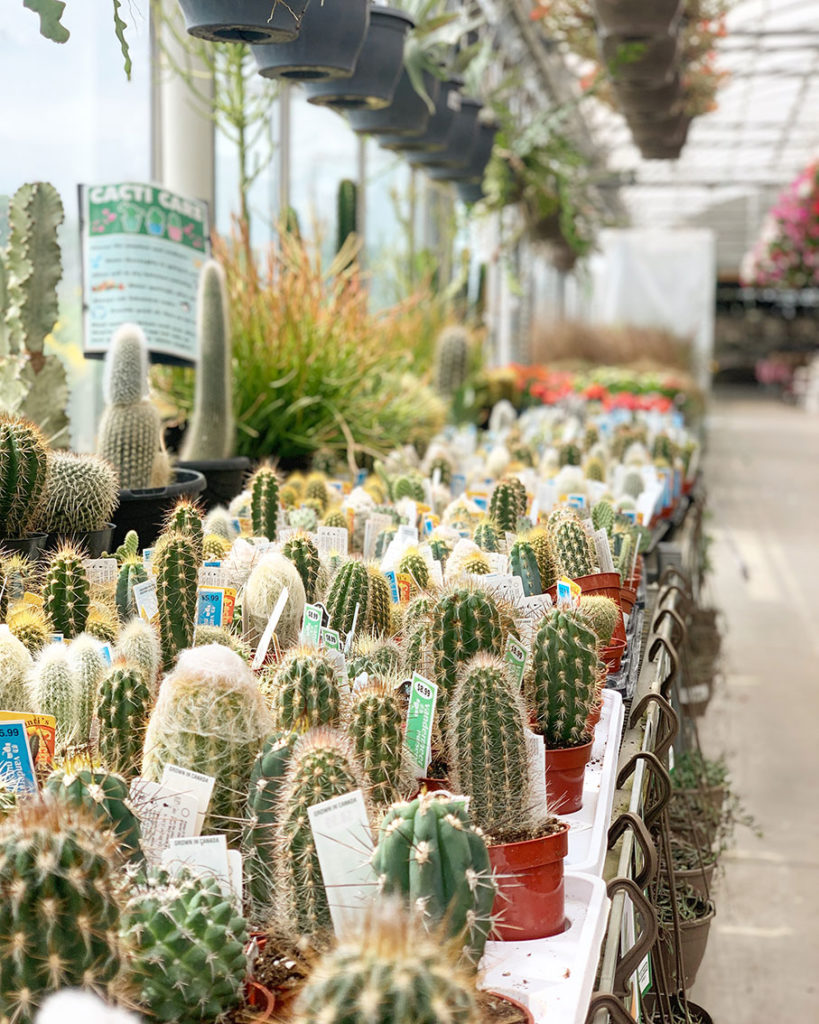HOUSEPLANTS
CACTI & SUCCCULENTS
All cacti are succulents but not all succulents are cacti. Confused? Keep reading to find out why and some tips and tricks to care for them!
Cacti vs. Succulent: What Makes Them Different?
Succulents are classified by their water storage properties! All succulents are able to efficiently store water for long periods of time using modified cell structures, though some are more efficient than others. Some species have modifications in their leaves (like Aloe), while others have modified stems (like most cacti), or even modifications to their roots (like Ceropegia woodii, also known as String of Hearts). This is why cacti are classified as a type of succulent.
Cacti, specifically, are succulents that are a member of the Cactaceae family, which have areoles and unique flower structures to distinguish them from other succulents. These areoles are soft, almost cushion-like spots on the stem of the cactus that act as the growth point for spines, flowers, fruits, and hairs. While most cacti have spines rather than leaves, this trait is not exclusive to cacti. There are still some succulents and other plants that have spines, but lack areoles so they are not classified as cacti. Because of these areoles, a cacti’s spine is independent organs and can break off quite easily.

Light
One of the most important care aspects for cacti and succulents (and arguably the hardest to provide in our area), is the light they require. While some tropical species can withstand being tucked into a dark corner, cacti and succulents are sun-lovers and will not survive in such a spot. The large majority of succulent species need as much direct sun as you can provide for them, with a few small exceptions (Schlumbergera for example). A sure sign that your plant is not receiving enough light is if they start exhibiting a symptom called “etiolation”. While etiolation sounds fancy, it is just a term for the plant “stretching” towards the light, and is characterized by long internodes (spaces between leaves), and pale, weak new growth. Once a plant’s growth is etiolated, that particular section of the plant cannot be corrected, but relocating the plant to a sunnier location can encourage stronger new growth.
Water
Improper watering is the most common reason that people are unsuccessful when growing cacti and succulents. Succulents are desert plants, and as we’ve mentioned, store their water for safe-keeping, which means they need far less frequent watering than your typical tropicals! Opt for deep waterings, soaking the entire soil mass, but let the excess drain away and let your soil dry out entirely before watering again. Keep in mind, your plant will need less frequent watering when it is in its dormancy period than when it is actively growing, so your frequency will vary throughout the year.
The main issue that arises tends to be over-watering, rather than under watering, so check thoroughly before you add more moisture, and remember… It is easier to fix issues caused by underwatering than it is to fix issues caused by overwatering.
Fertilizer
Just like any other houseplant, succulents should be fertilized to promote growth and prevent deficiencies. Choose a low-nitrogen or cacti-specific fertilizer and fertilize once a month during the growing season (generally May to September), at the recommended dose on the package. Most cacti fertilizers will be in liquid form, which is a great option as you can be precise for the dosage and the nutrients are immediately available to the plant.
Growing Mediums & Repotting

When selecting your pot, opt for one that is no more than 1” bigger than your current pot, and stay away from anything too deep. Cacti and succulent root systems are fairly shallow so they will not be able to uptake any water from the bottom of a deep pot, and all that excess water can cause rot issues in the roots as it sits. It is also vital that your container has a drainage hole to allow excess water to drain off.
In terms of material, terra cotta, clay, or unglazed ceramic are good options as they wick away moisture and ensure your soil medium dries out. Plastic pots are also an option as they usually have drainage holes, and they can be placed inside a glazed ceramic pot for a better-looking arrangement if you prefer. The only other consideration is some of your plants (cacti especially) may be quite top-heavy, so you should use a heavier pot to balance the plant.
When it comes time to repot, we highly recommend using a dedicated cacti & succulent potting mix! This will be a porous mixture that drains and dries quickly, and is highly aerated to prevent excess moisture from sitting. You can also try making your own if you prefer - sand, perlite, and pumice are all great additives if that’s a challenge you want to tackle!




